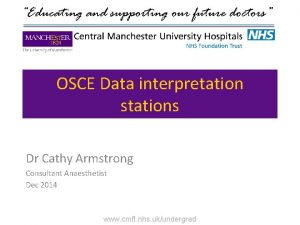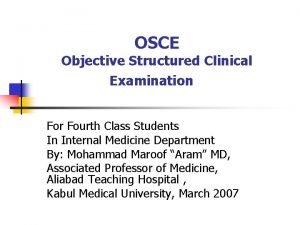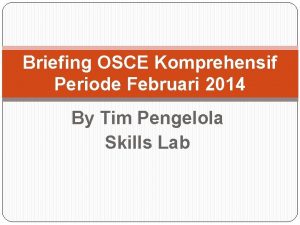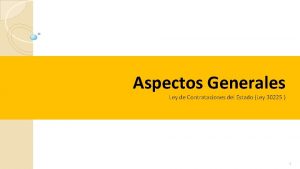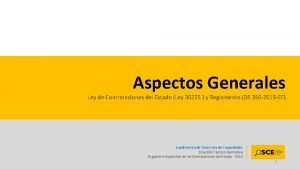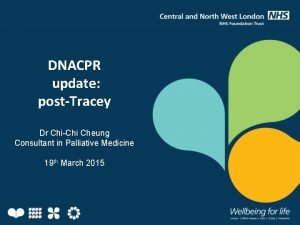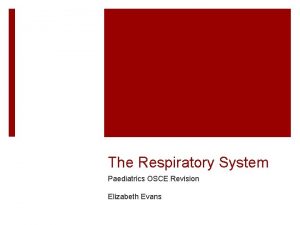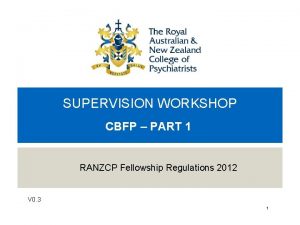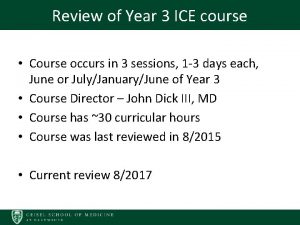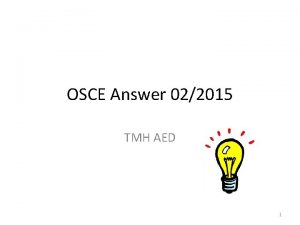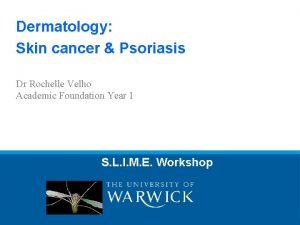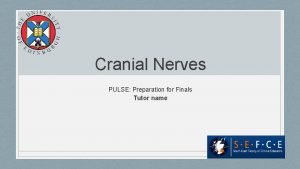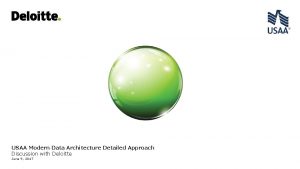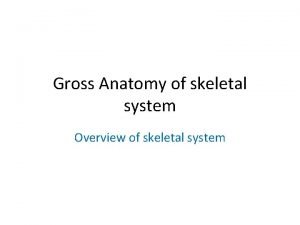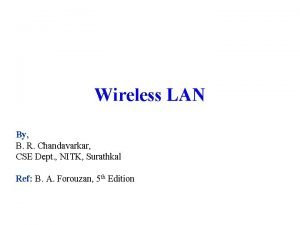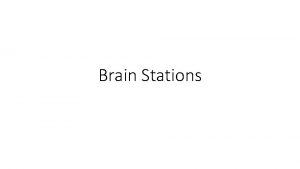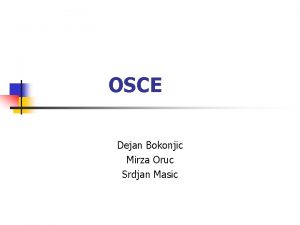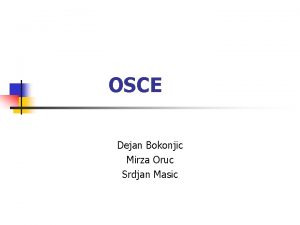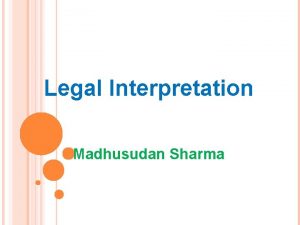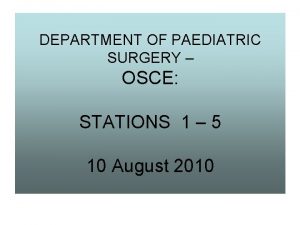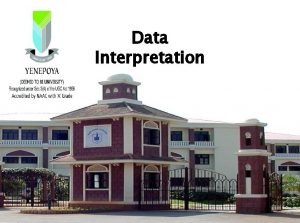OSCE Data interpretation stations Dr Cathy Armstrong Consultant


















































- Slides: 50

OSCE Data interpretation stations Dr Cathy Armstrong Consultant Anaesthetist Dec 2014 www. cmft. nhs. uk/undergrad

Objectives • The stations – Format – Tips • Blood tests – Patterns to look for • examples www. cmft. nhs. uk/undergrad

Format • Instructions – Brief background – Study data – ‘after 5 minutes the examiner will ask you some questions on diagnosis & initial management’ www. cmft. nhs. uk/undergrad

Format • Data – Blood tests – ECG – CXR – Observations www. cmft. nhs. uk/undergrad

Format • Questions from examiner – Structured / standardised • ‘what do the blood tests show? ’ • ‘what does the CXR show? ’ • What is your most likely diagnosis? What is your top differential? • What will your initial management be? www. cmft. nhs. uk/undergrad

Tips • Use your thinking time wisely • Use succinct language & be confident – Likely to be some normal investigations also • Show reasoning behind your thoughts • Flag up potential dangers www. cmft. nhs. uk/undergrad

Tips • Differential diagnosis – Start with your top & why • Initial management – Might include oxygen / fluids / nebulisers – Remember management packages – e. g septic 6 – Further detailed history – Other definitive investigations – e. g. echo, CT – Don’t forget SENIOR HELP / INPUT www. cmft. nhs. uk/undergrad

Investigations www. cmft. nhs. uk/undergrad

Full Blood Count • Hb – Males 135 – 180 g/l – Females 115 – 160 g/l • WCC – 4. 0 – 11 x 109/l • Platelets – 150 – 400 x 109/l www. cmft. nhs. uk/undergrad

Anaemia classification by MCV – mean cell volume (76 – 96 fl) • Normal MCV (Normocytic) – Acute blood loss – Anaemia of chronic disease • Low MCV (microcytic) – Iron deficiency – Thalassaemia • High MCV (Macrocytic) – B 12 or folate deficiency www. cmft. nhs. uk/undergrad

High wcc - neutrophilia • • Raised WCC most commonly due to neutrophilia Neutrophils account for 40 – 75% of WBC recognise & ingest foreign particles & microorganisms Causes of neutrophilia – Infection – – – Trauma Infarction Inflammation Malignancy Myeloproliferative disease Physiological (exercise & pregnancy) www. cmft. nhs. uk/undergrad

Low wcc - neutropenia § Most commonly caused by neutropenia § Causes of neutropenia § Infection § § Drugs Autoimmune Alcohol congenital www. cmft. nhs. uk/undergrad

Thrombocytosis • Reactive – – – Chronic inflammatory disorders Malignant disease Post-haemorrhage Post-splenectomy Haemolytic anaemias • Malignant – Essential thrombocythaemia – Polycythaemia rubra vera – myelofibrosis www. cmft. nhs. uk/undergrad

Thrombocytopenia • Marrow disorders – Hypoplasia – idiopathic, drug-induced – Infiltration • Leukaemia, Myeloma, Carcinoma, Myelofibrosis – B 12 / folated deficiency • Increased consumption of platelets – DIC, ITP, viral infections, bacterial infections • Hypersplenism – Lymphoma, liver disease www. cmft. nhs. uk/undergrad

Urea & electrolytes • • Na K Ur Cr 135 -145 mmol/l 3. 5 – 5. 5 mmol/l 2. 5 – 6. 7 mmol/l 70 – 150 mmol/l www. cmft. nhs. uk/undergrad

Hyperkalaemia • • • Mild Mod Severe 5. 5 - 6. 0 mmol/l 6. 1 – 7. 0 mmol/l > 7. 0 mmol/l • Causes – ↑ intake • Food ingestion / supplements • Rapid blood transfusion – Intercompartmental shifts • Trauma / crush injuries • Burns • Acidosis – Decreased excretion • Acute / chronic renal failure • Adrenocortical insufficiency (e. g. Addisons disease) – Medications www. cmft. nhs. uk/undergrad • Potassium sparing diuretics, digoxin

Hyperkalaemia § ECG changes § § § § Peaked T waves Prolonged PR interval Widened QRS Loss of P wave Loss of R wave amplitude Sine wave pattern Asystole § Management of mod / severe § § § Treat underlying cause Calcium gluconate Insulin dextrose infusion Nebulised salbutamol dialysis www. cmft. nhs. uk/undergrad

Hypokalaemia • • • Mild Mod Severe 3. 0 – 3. 5 mmol/l 2. 5 – 3. 0 mmol/l < 2. 5 mmol/l • Causes – ↓ intake • Iatrogenic (no K in IV fluids) • Malnutrition – Renal losses • Renal tubular acidosis • Hyperaldosteronism (Conn’s syndrome) – GI losses • Diarrhoea, vomiting – Intercompartmental shifts • insulin • Alkalosis – Medications • Diuretics, β 2 agonists www. cmft. nhs. uk/undergrad

www. cmft. nhs. uk/undergrad

Hypernatraemia • Usually due to water loss in excess of sodium loss • Causes include: – Iatrogenic (too much IV N saline) – Diabetes Insipidus – Primary aldosteronism (Conn’s Syndrome) www. cmft. nhs. uk/undergrad

Diseases with electrolyte patterns • Addisons disease (Primary adrenocortical insufficiency) – Na K Ca • Cushings syndrome (excess plasma cortisol) – Na K Ca • Conn’s Syndrome (hyperaldosteronism) – Na K www. cmft. nhs. uk/undergrad

Diseases with electrolyte patterns • Addisons disease (Primary adrenocortical insufficiency) – Na ↓ K↑ Ca ↑ • Cushings syndrome (excess plasma cortisol) – Na ↑ K↓ Ca ↓ • Conn’s Syndrome (hyperaldosteronism) – Na ↑ ↔ K↓ www. cmft. nhs. uk/undergrad

Raised Urea & creatinine • Both raised in renal failure • Alternative causes of a raised urea with relatively normal Cr – Dehydration – GI haemhorrhage – High protein diet www. cmft. nhs. uk/undergrad

Deciphering between acute & chronic renal failure using blood results § Chronic renal failure § Anaemia of chronic disease § Low calcium § High phosphate www. cmft. nhs. uk/undergrad

Liver Function tests Non-specific Bilirubin AST (Aspartate transaminase) ALP (Alkaline phophatase) γ – GT Specific ALT (Alanine aminotransferase) (Gamma –glutamyl transpeptidase) Albumin www. cmft. nhs. uk/undergrad

LFT patterns • Hepatocellular Damage – Large ↑ in ALT with small ↑ in ALP • Biliary obstruction – Small ↑ ALT with large ↑ in ALP & γ -GT www. cmft. nhs. uk/undergrad

Areas not covered • Clotting studies – Anticoagulant monitoring • CRP • Blood cultures • Specialist tests – E. g – vasculitis screens / immunology www. cmft. nhs. uk/undergrad

Normal ABG Values p. H 7. 35 - 7. 45 Pa. O 2 10 -12 k. Pa IN AIR Pa. CO 2 4. 5 - 6. 0 k. Pa HCO 3 22 – 26 mmol/l Base Excess -2 - +2 mmol/l Many modern gas machines also measure K+ Na+ Cl- Sa. O 2 Hb COHb Met. Hb Lactate www. cmft. nhs. uk/undergrad

Expected PO 2 on oxygen % oxygen – 10 www. cmft. nhs. uk/undergrad

Examples www. cmft. nhs. uk/undergrad

Ryan • Ryan is a 17 year old male. He has presented to A&E with a 2 month history of general malaise. Over the past few days he has been vomiting with stomach cramps. • BP 110/70, Apyrexial, RR 39 • Review the investigations provided. You will then be asked questions on diagnosis and initial management. www. cmft. nhs. uk/undergrad

Ryan www. cmft. nhs. uk/undergrad

Ryan • • • Hb 12. 9 (9. 0 – 13. 0) Wcc 7. 0 (4. 0 – 11. 0) Plt 395 (150 -400) • • Na 139 (135 -145) K 4. 5 (3. 5 -5. 5) Ur 15. 0 (3. 3 -6. 6) Cr 140 (80 -120) • Blood glucose 35 mmol/l • ABG on air • • • p. H 7. 12 (7. 35 -7. 45) PCo 2 3. 0 (4. 5 -6. 0) PO 2 11. 0 (10 -12 in air) HCO 3 17 (22 -26) BE -23 (-2 - +2) www. cmft. nhs. uk/undergrad

Ryan www. cmft. nhs. uk/undergrad

Jack • Jack is a 77 year old male. He has presented to A&E with a 2 day history of abdominal pain and vomiting. • BP 90/45, T 38. 5. RR 30 • Examination of the abdomen reveals a hard abdomen with generalised tenderness and guarding • Review the investigations provided. You will then be asked questions on diagnosis and initial management. www. cmft. nhs. uk/undergrad

Jack • • • Hb 9. 0 (9. 0 – 13. 0) Wcc 22. 3 (4. 0 – 11. 0) Plt 170 (150 -400) • • Na 139 (135 -145) K 4. 5 (3. 5 -5. 5) Ur 10. 0 (3. 3 -6. 6) Cr 130 (80 -120) • ABG on air • • • p. H 7. 22 (7. 35 -7. 45) PCo 2 6. 1 (4. 5 -6. 0) PO 2 7. 5 (10 -12 in air) HCO 3 18 (22 -26) BE -10 (-2 - +2) www. cmft. nhs. uk/undergrad

Jack www. cmft. nhs. uk/undergrad

Jack www. cmft. nhs. uk/undergrad

Dorothy • Dorothy is a 82 year old female. She has presented to A&E with a 5 day history of productive cough with green sputum and worsening shortness of breath. • BP 93/50, T 38. 5. RR 32 • Review the investigations provided. You will then be asked questions on diagnosis and initial management. www. cmft. nhs. uk/undergrad

Dorothy • • • Hb 11. 0 (9. 0 – 13. 0) Wcc 21. 0 (4. 0 – 11. 0) Plt 250 (150 -400) • • Na 139 (135 -145) K 4. 5 (3. 5 -5. 5) Ur 8. 0 (3. 3 -6. 6) Cr 90 (80 -120) • ABG on 60% oxygen • • • p. H 7. 35 (7. 35 -7. 45) PCo 2 4. 2 (4. 5 -6. 0) PO 2 13 (10 -12 in air) HCO 3 23 (22 -26) BE -3 (-2 - +2) www. cmft. nhs. uk/undergrad

Dorothy www. cmft. nhs. uk/undergrad

Dorothy www. cmft. nhs. uk/undergrad

CURB 65 • • Confusion Urea – 7. 0 or over RR 30 or over BP – Systolic 90 or less OR – Diastolic 60 or less • Age 65 or over www. cmft. nhs. uk/undergrad

Sepsis 6 • • • Oxygen Blood cultures IV antibiotics Lactate & FBC IV fluids Measure UO www. cmft. nhs. uk/undergrad

Tom • Tom is a 22 year old male. He has presented to A&E with shortness of breath and an audible wheeze • BP 135/90, T 36. 5. RR 38 • Review the investigations provided. You will then be asked questions on diagnosis and initial management. www. cmft. nhs. uk/undergrad

Tom • • Hb 11. 0 (9. 0 – 13. 0) Wcc 6. 0 (4. 0 – 11. 0) Plt 250 (150 -400) Na 139 (135 -145) K 4. 5 (3. 5 -5. 5) Ur 5. 9 (3. 3 -6. 6) Cr 80 (80 -120) • ABG on 15 L oxygen via non-rebreath mask • • • p. H 7. 32 (7. 35 -7. 45) PCo 2 5. 9 (4. 5 -6. 0) PO 2 9 (10 -12 in air) HCO 3 23 (22 -26) BE -3 (-2 - +2) www. cmft. nhs. uk/undergrad

Tom www. cmft. nhs. uk/undergrad

Tom www. cmft. nhs. uk/undergrad

summary § Read instructions carefully § Take time to look at data, formulate a differential diagnosis & initial management plan § Be confident in your approach § Remember senior input www. cmft. nhs. uk/undergrad

www. cmft. nhs. uk/undergrad
 Conn’s syndrome
Conn’s syndrome Pc hpc pmh dh
Pc hpc pmh dh Osce medical
Osce medical Osce documentation centre in prague
Osce documentation centre in prague Mercedes benz incision
Mercedes benz incision Ospe and osce
Ospe and osce Osce komprehensif adalah
Osce komprehensif adalah Osce
Osce Osce
Osce Procedimiento de selección osce
Procedimiento de selección osce Dnacpr osce
Dnacpr osce Respiratory system osce
Respiratory system osce Ranzcp wba
Ranzcp wba Ice osce
Ice osce Question
Question Rochelle velho
Rochelle velho Cranial nerve osce
Cranial nerve osce How does interpretation b differ from interpretation a
How does interpretation b differ from interpretation a Modern data architecture consultant
Modern data architecture consultant Gerald graff
Gerald graff Cyrus trask
Cyrus trask Cathy bedrick kpmg
Cathy bedrick kpmg Cathy wainhouse
Cathy wainhouse Cathy jenner
Cathy jenner Ajh photography
Ajh photography Cathy curry ottawa
Cathy curry ottawa Hazelwood v kuhlmeier background
Hazelwood v kuhlmeier background Cathy blunt
Cathy blunt Cathy berkman
Cathy berkman Cathy alderman
Cathy alderman S. cathy sapp nn7242582670
S. cathy sapp nn7242582670 Cathy moore action mapping
Cathy moore action mapping Cathy chuang
Cathy chuang Sally left the party to take cathy home
Sally left the party to take cathy home Cathy has a nickel a dime
Cathy has a nickel a dime Better health together
Better health together Liza hamilton east of eden
Liza hamilton east of eden Cathy manduca
Cathy manduca Cathy legg
Cathy legg Cathy dunne
Cathy dunne Cathy abraham
Cathy abraham Cathy landon
Cathy landon Ten thousand airline reservation stations are competing for
Ten thousand airline reservation stations are competing for Station model symbols
Station model symbols The way of the cross 14 stations
The way of the cross 14 stations Stations of the cross for teachers
Stations of the cross for teachers Which of the reporting stations have vfr weather?
Which of the reporting stations have vfr weather? Radio telex
Radio telex Stations design sicily
Stations design sicily Stations of the cross we adore you
Stations of the cross we adore you Stations of the cross introduction
Stations of the cross introduction
